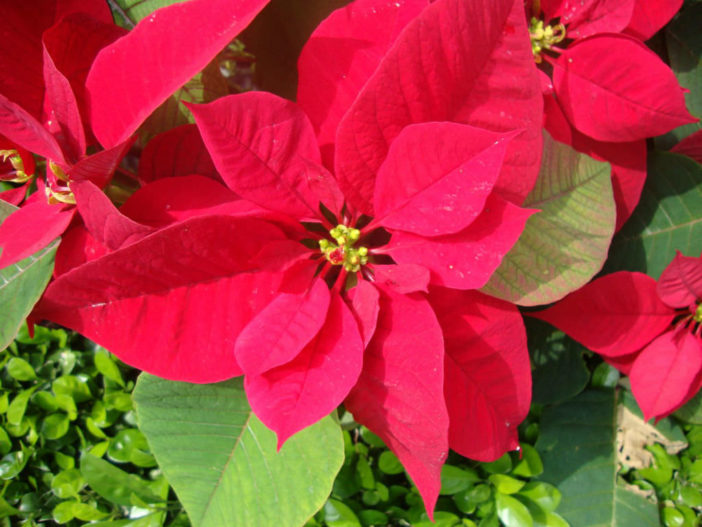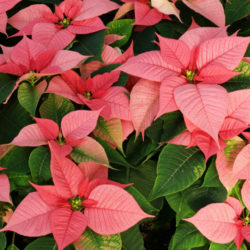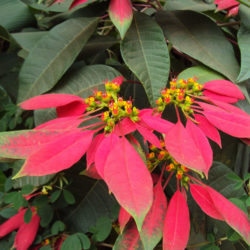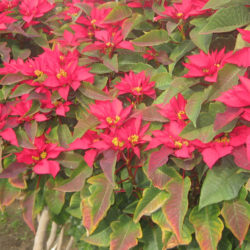Scientific Name
Euphorbia pulcherrima Willd. ex Klotzsch
Common Name(s)
Bird-of-paradise Flower, Christmas Eve Flower, Christmas Flower, Christmas Star, Fire on the Mountain, Fire Plant, Lobster Flower, Mexican Easter Flower, Mexican Flameleaf, Painted Leaf, Poinsettia, Pride of Barbados
Synonym(s)
Euphorbia coccinea, Euphorbia lutea, Euphorbia poinsettiana, Poinsettia pulcherrima
Scientific Classification
Family: Euphorbiaceae
Subfamily: Euphorbioideae
Tribe: Euphorbieae
Subtribe: Euphorbiinae
Genus: Euphorbia
Origin
Euphorbia pulcherrima is native to the tropical deciduous forest of Mexico and is now widely cultivated in tropical and subtropical regions around the world.
Description
Euphorbia pulcherrima is a shrub or small tree with branches that bear dark green leaves and bright red petal-like bracts with tiny yellow flowers in the center. It can grow up to 13 feet (4 m) tall. The leaves are broadly ovate with entire margins or somewhat lobed, reaching up to 8 inches (20 cm) in length and 4 inches (10 cm) in width. They are attached to the branches by a petiole up to 2 inches (5 cm) long.
The colored bracts are usually red but can be pink, orange, pale green, cream-colored, white, or marbled. They are narrowly elliptic, up to 2.8 inches (7 cm) long and 0.8 inches (2 cm) wide. The colors of the bracts are created through photoperiodism, which means they need darkness, 12 hours at a time for at least five days in a row, to change the color. The flowers appear in winter. They are grouped within small yellow structures called cyathia, found in the center of each leaf bunch. The fruits are spherical 3-lobed capsules and contain gray or light gray seeds.

Hardiness
USDA hardiness zones 10a to 11b: from 0 °F (−1.1 °C) to 50 °F (+10 °C).
How to Grow and Care
Euphorbias are very easy to care for. These plants require a little pampering to become established, but once they are, they are self-sufficient. More die from too much care and watering than from neglect. Euphorbias need well-draining soil and lots of sunlight. They are not particular about soil pH, but they cannot tolerate wet soil. Unlike most succulents, Euphorbia does not handle long periods of drought well. It may need weekly watering during the summer. Water whenever the soil is dry several inches below the surface. Water deeply, but don't let them sit in wet soil, which can cause root rot. Add some organic matter or fertilizer to the planting hole. Feed with a half-strength fertilizer monthly if you are growing them in containers or your soil is poor.
These succulents can be grown from seed, but they can be difficult to germinate (or even find). They are usually propagated by cuttings. This can be tricky because of the exuding sap. Rooting hormone is recommended with Euphorbias. They tend to grow problem-free, but there are a few pests and diseases to be alert for.
See more at How to Grow and Care for Euphorbia.
Links
- Back to genus Euphorbia
- Succupedia: Browse succulents by Scientific Name, Common Name, Genus, Family, USDA Hardiness Zone, Origin, or cacti by Genus
Photo Gallery
Click on a photo to see a larger version.


